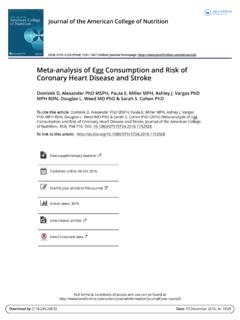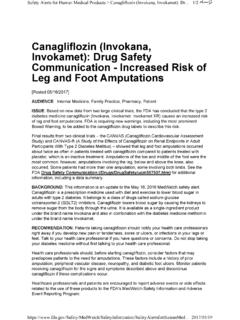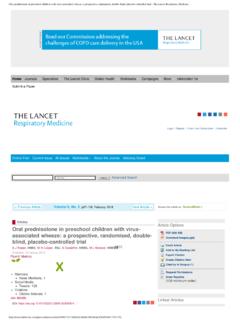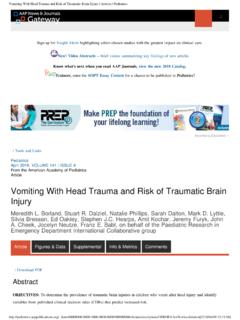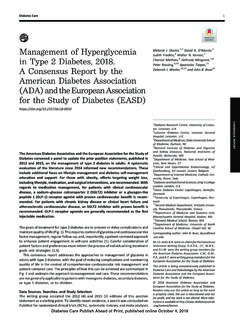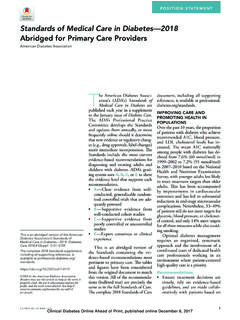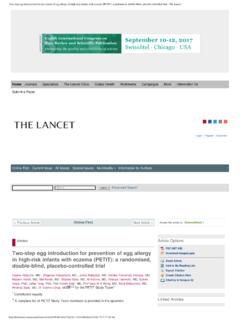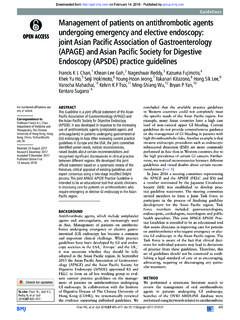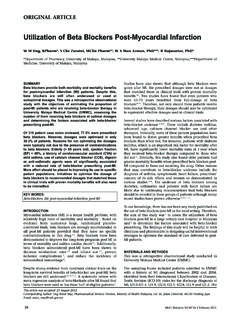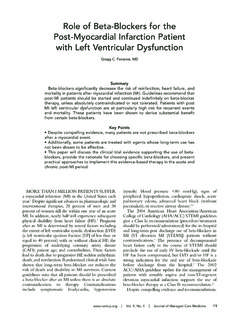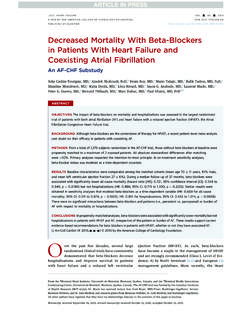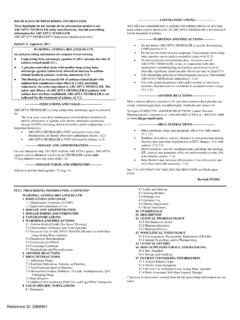Transcription of Effect of age and sex on efficacy and tolerability of β ...
1 RESEARCH. open access Effect of age and sex on efficacy and tolerability of blockers in patients with heart failure with reduced ejection fraction: individual patient data meta-analysis Dipak Kotecha,1,2 Luis Manzano,3 Henry Krum,2 Giuseppe Rosano,4,5 Jane Holmes, 6. Douglas G Altman,6 Peter D Collins,7 Milton Packer,8 John Wikstrand,9 Andrew J S Coats,10,11. John G F Cleland,7 Paulus Kirchhof,1 Thomas G von Lueder,12 Alan S Rigby,13 Bert Andersson,9. Gregory YH Lip,1 Dirk J van Veldhuisen,14 Marcelo C Shibata,15 Hans Wedel,16 Michael B hm,17. Marcus D Flather18 on behalf of the Beta-Blockers in Heart Failure Collaborative Group For numbered affiliations see ABSTRACT follow-up of years (number needed to treat 23).
2 End of article. Objectives Admission to hospital for heart failure was significantly Correspondence to: D Kotecha, To determine the efficacy and tolerability of blockers reduced by blockers, although this Effect was University of Birmingham in a broad age range of women and men with heart attenuated at older ages (interaction P= ). There Institute of Cardiovascular Sciences, Medical School, failure with reduced ejection fraction (HFrEF) by was no evidence of an interaction between treatment Edgbaston, Birmingham B15 pooling individual patient data from placebo Effect and sex in any age group. Drug discontinuation 2TT, UK controlled randomised trials. was similar regardless of treatment allocation, age, or Additional material is published sex ( in those give blockers, in those online only.)
3 To view please visit Design the journal online. Prospectively designed meta-analysis of individual receiving placebo). Cite this as: BMJ 2016;353:i1855 patient data from patients aged 40-85 in sinus rhythm Conclusion at baseline, with left ventricular ejection fraction Irrespective of age or sex, patients with HFrEF in sinus Accepted: 14 March 2016 < rhythm should receive blockers to reduce the risk of Participants death and admission to hospital. 13 833 patients from 11 trials; median age 64; 24% Registration women. PROSPERO CRD42014010012; Main outcome measures NCT00832442. The primary outcome was all cause mortality; the major secondary outcome was admission to hospital Introduction for heart failure.
4 Analysis was by intention to treat with blockers reduce morbidity and mortality in patients an adjusted one stage Cox proportional hazards with heart failure and reduced left ventricular ejection model. fraction and are a cornerstone of modern evidence Results based treatment. Current heart failure guidelines do not Compared with placebo, blockers were effective in differentiate treatment on the basis of age or sex, reducing mortality across all ages: hazard ratios were although initiation and maintenance of treatment is (95% confidence interval to ) for the first suboptimal both in older people and With quarter of age distribution (median age 50); ( increasing age, patients are more likely to be women to ) for the second quarter (median age 60); (with less marked reduction in left ventricular ejection ( to ) for the third quarter (median age 68).)
5 Fraction). This interaction, along with relatively low and ( to ) for the fourth quarter (median numbers of older patients in randomised controlled tri- age 75). There was no significant interaction when age als, has created uncertainty about the optimum man- was modelled continuously (P= ), and the absolute agement of elderly patients with heart failure and reduction in mortality was over a median reduced ejection fraction (HFrEF), both in women and men. Moreover, there are theoretical concerns about What is already known on this topic altered pharmacokinetics in older people that might affect the dose required or the tolerability of treat- blockers can reduce mortality and hospital admission in patients with heart 5 Although subgroup data and the results from failure with reduced ejection fraction and sinus rhythm SENIORS (Study of the Effects of Nebivolol Intervention Older patients and women often receive less evidence based treatment and often at on Outcomes and Rehospitalisation in Seniors with lower doses than shown to be effective in clinical trials Heart Failure)
6 Suggest that the efficacy of blockers is What this study adds retained in older patients,6-8 low uptake and poor main- tenance of treatment continue to be a clinical reality. This study used individual patient data from all major randomised controlled trials The Beta-blockers in Heart Failure Collaborative comparing blockers with placebo in patients with heart failure with reduced Group was set up to combine individual patient data ejection fraction and sinus rhythm from major randomised controlled trials in heart failure In these patients, treatment with blockers reduced all cause mortality and and provide clear direction on clinically relevant hospital admissions for heart failure, regardless of age or sex.
7 And the tolerability of subsets of patients in which there is uncertainty about treatment was the same with blockers and placebo the balance of safety and efficacy of 10 the bmj | BMJ 2016;353:i1855 | doi: 1. RESEARCH. Meta-analysis of individual patient data allows more example, Medline and Current Contents), scrutiny of robust examination of treatment effects in subgroups reference lists of trials, trials registries, meeting and enables of time to event analyses adjusted for base- abstracts, and review articles as well as discussion with line covariates, making it ideal for the appropriate pool- group members and pharmaceutical manufacturers. ing of original We have previously shown that We included randomised controlled trials that reported morbidity and mortality are not improved by blockers mortality as a primary outcome or part of a composite in patients with HFrEF and concomitant atrial fibrilla- outcome comparing blockers versus placebo.
8 Only tion, in contrast with patients in sinus rhythm, who had unconfounded head to head trials were eligible, with substantial reductions in admission to hospital and all recruitment of over 300 patients and planned follow-up cause of more than six months to make the project technically In this analysis, we explored the interactions of feasible and clinically relevant. The search results, indi- blocker efficacy and tolerability with age and sex, using vidual study demographics and a standardised data the largest and most robust dataset of pooled data from request form to obtain individual patient data from randomised trials. Our aim was to inform clinicians on each trial have been the appropriate use of these important therapeutic The 11 included studies account for of eligible agents for patients with HFrEF in sinus rhythm.
9 Participants recruited in randomised controlled trials based on a systematic literature review: the Australia/. Methods New Zealand Heart Failure Study (ANZ),14 the Beta- The Beta-blockers in Heart Failure Collaborative Group Blocker Evaluation Survival Trial (BEST),15 the Carve- (BB-meta-HF) is a multinational effort, combining indi- dilol Post-Infarct Survival Control in LV Dysfunction vidual data from the major randomised controlled trials Study (CAPRICORN),16 the Carvedilol Hibernating investigating the use of blockers in heart failure. The Reversible Ischaemia Trial: Marker of Success Study group consists of the leading investigators of these trials (CHRISTMAS),17 the Cardiac Insufficiency Bisoprolol and international experts, with the support of the four Study (CIBIS I),18 the Cardiac Insufficiency Bisoprolol pharmaceutical companies that conducted the original Study II (CIBIS-II),19 the Carvedilol Prospective Ran- trials (AstraZeneca, GlaxoSmithKline, Merck Serono, domised Cumulative Survival Study (COPERNICUS),20 and Menarini).
10 This report was prepared according to the Metoprolol in Idiopathic Dilated Cardiomyopathy the Preferred Reporting Items for Systematic reviews Study (MDC),21 the Metoprolol CR/XL Randomised and Meta-Analyses of individual participant data (PRIS- Intervention Trial in Congestive Heart Failure (MER- MA-IPD) guidelines13 and prospectively registered with IT-HF),22 23 the SENIORS Study,8 and the US Carvedilol (NCT0083244) and the PROSPERO Heart Failure Study (US-HF).24 All included studies had database of systematic reviews (CRD42014010012).10 low overall risk of bias, as determined with the Detailed rationale and methods have previously been Cochrane Collaboration's risk of bias 12. Patient involvement Eligibility, search strategy, and data collection We have insufficient evidence to comment on whether Published or unpublished randomised controlled trials patients were actively involved in the design or manage- were identified through computer aided searches (for ment of these 11 trials.)
